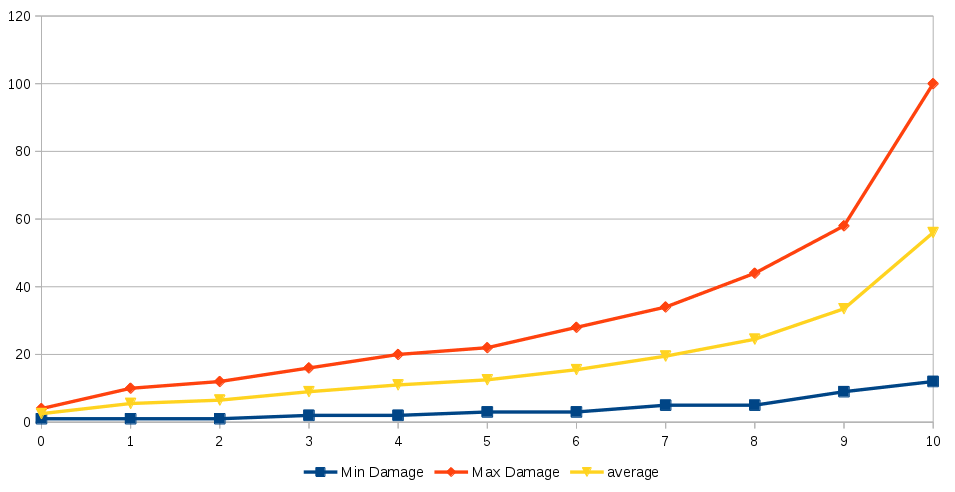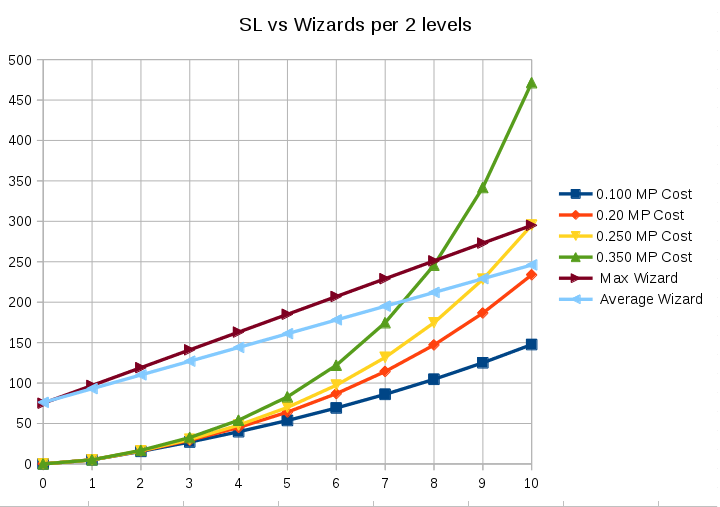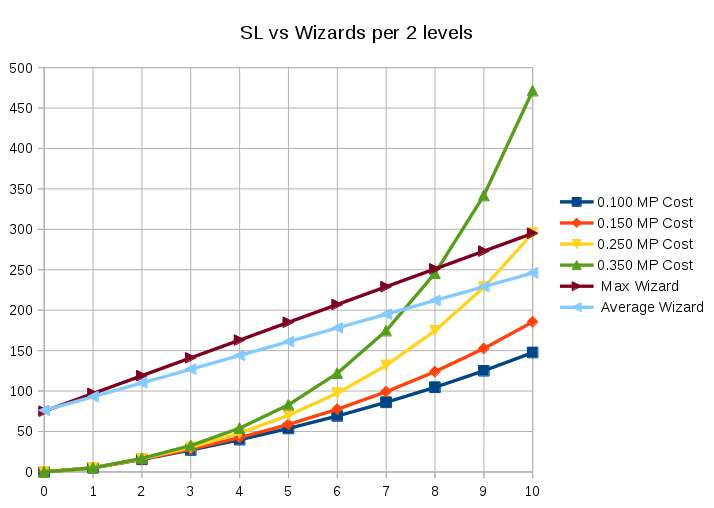If you plan to create a tabletop (or computer-based) game, you need to know about curves. You need to understand the power curve and how to use it. Don’t worry. It is quite easy to do.
Here, is an example of baseline damage per spell level when the dice are converted into averages, lowest rolls and highest rolls. The hard to get and use – 10th level spells – sits high above the steady progression curve. This reflects both their utility and difficulty in deployment. At least, in the in theory game that this was designed for.

It does not matter how fast the curve climbs what matters is that it does so at a steady and predictable pace. More importantly, everything of a given level will fall somewhere on the power curve. Anything with an average that puts it notably above the curve can invalidate everything else in its class.
Comparing like for like
If most level three spells and items can be relied on to do 2d8 (2 to 16) damage, it only takes one 4d6 (4 to 24) to make others seem worthless and underpowered. Likewise, a 3d4 (3 to 12) item at level three falls so far below the curve as to be functionally useless. These examples clearly do not belong in the same class.
Even if the players are not aware of your games power curve, they will still ignore underpowered items or spells, Anything weaker in a given level will be skipped in favour of ones that give a bigger bang.
This is why, in games like Dungeons and Dragons and Pathfinder, spells of a particular level tend to have fairly similar damage profiles. A utility spell of a similar level generally feels like it is worth a spell slot or it gets left in favour of more damage.
Consider 5e’s paladin spells. At any given level they all do about the same damage. However not as much as the channel ability does. Which is why paladin players tend to sped spell slots adding extra damage to attacks. The ability is just above the spell’s power curve and, objective, better.
When an item is overpowered
That feeling of “worth the spell slot” is the power curve at play. There is a reason why Warlocks pretty ubiquitously choose Eldritch Blast. It is well above the power curve with 1d10 damage for a cantrip (level zero spell). Moreover, the spell levels up with you.
Eldritch Blast packs so much punch that a warlock not casting it on their seems like a wasted attack. By level 17, you are getting 4d10 (4 to 40) for free.
For almost all casters and classes, there is a good case to be made for taking the magic initiate feat. Mostly to grab Eldritch Blast because why would you want to use spell slots when you can get all that for free?
Linear vs curved progression

In this chart, we see a steady linear increase in magic points. That linear progression intersects with the cost curve of higher-level spells.
With this match up, the wizard is overpowered at low levels and struggling at higher levels. This is because linear progression matches poorly to a curved progression. There are few ways to rebuild those flat lines to fit the growth curve in a way that feels like each level is a step up in power.
Which is why the first chart started flat and only began to rise at the end.
It is not a great fit but it makes some steps towards game balance.
Fortunately, this is not a game currently in production. These are thought experiment power charts for a game discussion I had recently. They do serve to show, however, that being mindful of the power curve matters.
Power Creep
Without an established baseline for damage against spell level (or power for a certain mana cost), you risk power creep.
All it takes is one spell, item, or ability that sounds like a nice idea but gets put into too low a level spell slot to break your game. An end game item players can get hold of way before the end game is just as bad. As you continue to flesh out your spells, items, weapons, abilities and so forth, you will unconsciously be asking yourself, is this going to be better than or more fun than whatever the most powerful item you have made in that category is? The temptation is to make objectively better items for that category. This leaves the objectively worse items and spells essentially useless and playable. This is power creep.
Power creep during game design is a bad mistake. Even as you begin to flesh out your world, you have accidentally also deleted work you already did as not worth the players time. Unless you fix this by pushing cards, spells, or objects to a higher level or cost, all must match the most powerful thin in that class.
Do this too often and you will end up with a lot of content no one uses and a few game breakers with world ending power that are all a player feels is worth using.
Create a curve and stick to it religiously
Make sure that, both mathematically and from a player experience perspective, all spells of a given level feel about equal. A few underpowered items that could, in some edge cases, be useful are fine but one game breaker is all it takes to nullify all the content you created for that power level.
Non-combat, buff, debuff, and utility spells should feel worth the cost of giving up space for something that deals damage. It should feel like it has the same power over the world in the situations it might be used. There is no easy way to gauge player feel wich is why we have beta testing to see how players react to the options you have given them.
By applying a formula that a given amount of damage, buff, or debuff is roughly equal will allow you to keep the cost for power in balance. If the formula was wrong, beta testing should pick that up and you still have time to rebalance your power curve.
There is a reason Warlocks gain one overpowered cantrip in Dungeons and Dragons 5e – they have a tiny selection of spell slots that they can burn through quickly. Without the Eldritch Blast cantrip, the class just would not be worth playing. Which is why it levels with the Warlock. The Warlock is, without Eldritch Blast, objectively a class that falls below the power curve.
As game designers we cannot afford not to plot and track the power curve of our game items, spells, and abilities. Without an awareness of how all the items in a spell level of item class stack up with each other, you could be stuck in beta trying to tune your game forever.

